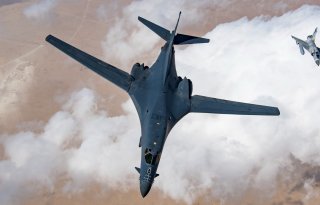Too Many Targets: The Air Force Needs More Bombers
At least one expert believes the abrupt end to the Continuous Bomber Rotation effort signals a further decline in the Air Force’s ability to project long-range firepower.
Here's What You Need to Remember: The Air Force six days later launched its first dynamic bomber sortie. A single B-1 took off from its base in South Dakota and, over the course of a 30-hour sortie, flew all the way to Japan and formed up with Japanese air force F-2 and F-15 fighters and locally-based U.S. Air Force F-16s before turning back toward the United States.
In mid-April 2020 the Air Force abruptly ended its 16-year-old rotation of B-1, B-2, and B-52 bombers at Andersen Air Force Base in Guam.
At least one expert believes the abrupt end to the Continuous Bomber Rotation effort signals a further decline in the Air Force’s ability to project long-range firepower.
“The Air Force knows this mission area is stretched too thin,” retired Air Force major general Larry Stutzriem and Douglas Birkey wrote in Defense News.
Stutzriem is the director of studies at the Mitchell Institute for Aerospace Studies in Virginia. Birkey is the institute’s executive director
The flying branch, however, put a happy spin on the decision to halt the bomber rotation, which since 2004 has maintained a small force of bombers in the western Pacific region in order to deter Chinese aggression.
Bombers aren’t necessarily going to deploy less often or in fewer numbers, the Air Force implied. Rather, they’re simply going to deploy less predictably under a new scheme the service calls “dynamic force employment.”
“Our diverse bomber fleet – B-52, B-1, and B-2 – allows us to respond to global events anytime, anywhere. Whether they’re launched from Louisiana, Guam or the U.K., long-range strategic bombers have and will remain a bedrock of our deterrence!” Air Force Global Strike Command tweeted on April 16, 2020.
The Air Force six days later launched its first dynamic bomber sortie. A single B-1 took off from its base in South Dakota and, over the course of a 30-hour sortie, flew all the way to Japan and formed up with Japanese air force F-2 and F-15 fighters and locally-based U.S. Air Force F-16s before turning back toward the United States.
The B-1 sortie might have seemed to underscore the Air Force’s continuing commitment to a global bomber presence despite the flying branch also planning on cutting its 157-strong bomber fleet by one B-2 and 17 B-1s.
The service as part of its 2021 budget submission has asked Congress for permission to begin decommissioning the bombers. The B-1s, in particular, suffered from overuse over Afghanistan and the Middle East in the decades following the Sept. 11, 2001 terror attacks -- and also suffered from a dearth of maintenance.
The result in 2019 was an abysmal readiness rate for the swing-wing bomber. In July 2019 just seven of 62 B-1s were fully mission-capable, South Dakota senator Mike Rounds revealed. Readiness somewhat improved in 2020.
The Air Force framed the first “dynamic” B-1 mission as evidence of the service’s enduring an undiminished ability to deploy long-range airpower. But Stutzriem and Birkey see the situation differently.
The defunct bomber-rotation was “a tremendous success,” they wrote. “It clearly communicated U.S. readiness to act decisively when U.S. and allied interests were challenged.”
Halting the bomber rotation “now sends the opposite message, just as the region grows more dangerous,” Stutzriem and Birkey added. “This is a decision with significant risk, yet it is an outcome compelled by past choices resulting in a bomber force on the edge.”
David Axe was defense editor at The National Interest. He is the author of the graphic novels War Fix, War Is Boring and Machete Squad. This article first appeared last year.
Image: Flickr.

